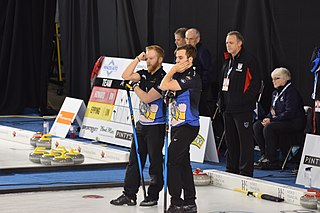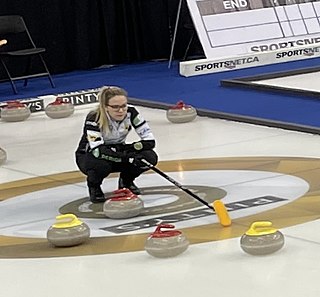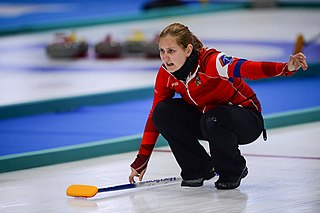Related Research Articles

Curling is a sport in which players slide stones on a sheet of ice toward a target area which is segmented into four concentric circles. It is related to bowls, boules and shuffleboard. Two teams, each with four players, take turns sliding heavy, polished granite stones, also called rocks, across the ice curling sheet toward the house, a circular target marked on the ice. Each team has eight stones, with each player throwing two. The purpose is to accumulate the highest score for a game; points are scored for the stones resting closest to the centre of the house at the conclusion of each end, which is completed when both teams have thrown all of their stones once. A game usually consists of eight or ten ends.
This is a glossary of terms in curling.

John C. Morris is a Canadian curler, and two-time Olympic gold medallist from Canmore, Alberta. Morris played third for the Kevin Martin team until April 24, 2013. Morris, author of the book Fit to Curl, is the son of Maureen and Earle Morris, inventor of the "Stabilizer" curling broom. Morris grew up in Gloucester, Ontario and at the age of five began curling at the Navy Curling Club.

Wheelchair curling is an adaptation of curling for athletes with a disability affecting their lower limbs or gait. Wheelchair curling is governed by the World Curling Federation, and is one of the sports in the Winter Paralympic Games.

The Continental Cup is a curling tournament held annually between teams from North America against teams from the rest of the World. Each side is represented by six teams, which compete using a unique points system. The tournament is modeled after golf's Ryder Cup., but unlike the Ryder Cup, the Continental Cup has never been held outside of North America nor has it been a regular, biennial event. The inaugural Continental Cup was held in 2002 but was held only three times between 2005 and 2010. Since 2011, however, the Continental Cup has been an annual competition.

Johan Niklas Edin is a Swedish curler. He currently resides in Karlstad, which has been his curling home base since 2008. He holds several sport distinctions. He is the first and the only skip in World Curling Federation (WCF) history to win three Olympic medals – gold (2022), silver (2018), and bronze (2014) – and to skip men's curling teams to six World Men's Curling Championship medals. He is also a seven-time European Curling Championship titleholder and won three silver medals in those championships. He is currently tied with Oskar Eriksson in first place on the WCF-recognized list of championship medals, with thirty-eight in total. He reached the playoffs in thirty-seven Grand Slam of Curling events and won the Pinty's Cup with his current teammates, Oskar Eriksson, Rasmus Wranå, and Christopher Sundgren. With the same lineup in 2022, Edin and his teammates also became the first and only men's curling team to win a fourth consecutive World Men's Curling Championship. Edin has played exclusively in the position of skip since 2007. The team bearing his name has been ranked on the World Curling Tour as high as No. 1, including for most of the 2017–18 season. As of the end of the 2021–22 Curling Season, Team Edin was ranked in the top three teams in the world.
In the sport of curling, the skip is the captain of a team. The skip determines strategy, and holds the broom in the house to indicate where a teammate at the other end of the curling sheet should aim the stone. The skip usually throws the last two stones in the fourth position, but may play in any other position.
Joseph Polo is an American curler who is best known for winning a bronze medal at the 2006 Winter Olympics and being the alternate on the gold-medal winning United States men's team at the 2018 Winter Olympics. Polo was raised in Floodwood, Minnesota before moving to Cass Lake. He learned to curl in nearby Bemidji at the age of 10 in the Bemidji Curling Club's Sunday Night Junior League.

The World Curling Tour (WCT) is a group of curling bonspiels featuring the best male, female, and mixed doubles curlers in the world.

Lesley Kaitlyn Lawes is a Canadian curler. Lawes was the long time third for the Jennifer Jones team that represented Canada at the 2014 Winter Olympics where they won the gold medal. They were the first women's team to go through the Olympics undefeated and the first Manitoba based curling team to win at the Olympics. Lawes curled with John Morris in the mixed doubles event at the 2018 Winter Olympics where they won gold. This win made her and Morris the first Canadian curlers to win two Olympic gold medals, and Lawes was the first to win gold in two consecutive Olympics.
Jason Smith is an American curler from St. Paul, Minnesota.

Oskar Ingemar Eriksson is a Swedish curler from Karlstad. He currently plays third for the Niklas Edin rink. He is the first curler in history to win four Olympic medals – gold, silver, and two bronze – and the first to secure two Olympic medals in different curling disciplines in the same Olympic Games. He is also a six-time World Men's Curling Champion, seven-time European Men's Curling Champion, and the first curler in history to win three gold medals in major international curling championships in a single calendar year – the World Men's Curling Championship, the European Curling Championship, and the World Mixed Doubles Championship. Having also won two World Mixed Doubles Championship medals, he is the first and the only curler to have seven World Curling Championship gold medals in the senior men's division and has won twelve World Curling Championship medals overall in that division. He also holds the record for most gold medals in international competitions as recognized by the World Curling Federation. He is the only member of Team Sweden to have competed in all of the World Men's Curling Championships from 2011 to 2021. He won medals in all but one of these championships, as well as playing in multiple positions – as skip, third, second, and as an alternate. In 2022, Eriksson and his teammates also became the first men's team in history to win four consecutive World Men's Curling Championships, with Eriksson and Niklas Edin becoming the first and only two curlers in history to have six career gold World Men's Curling Championship medals.

Laura Walker is a Canadian curler from Edmonton, Alberta. She is a two-time Canadian University champion, a national junior champion, world junior silver medallist and world mixed doubles bronze medallist. Walker is originally from Scarborough, Ontario.

Rebecca Lynn Hamilton is an American curler from McFarland, Wisconsin. She is a two-time national women's champion, a two-time national junior champion, and a two-time Olympian. At the 2018 PyeongChang Olympics, she competed in mixed doubles curling with her brother, Matt, along with playing with the women's curling team. She was again on the women's curling team during the 2022 Beijing Olympics.

Alina Pätz is a Swiss curler. She currently throws fourth stones on Team Silvana Tirinzoni. She is a six-time world champion and was the alternate player for the Mirjam Ott rink, which represented Switzerland at the 2014 Winter Olympics.
Tabitha Skelly Peterson is an American curler from Minneapolis, Minnesota. She was a bronze medalist at the 2010 World Junior Championships and is a three-time women's national champion. She currently is skip of her own team, having traded positions with Nina Roth during the 2020 off-season.
Amos Mosaner is an Italian curler from Cembra. He is an Olympic gold medallist, having won the mixed doubles event at the 2022 Winter Olympics with partner Stefania Constantini.

Zuzana Paulová is a Czech curler.

Yannick Schwaller is a Swiss curler from Recherswil. He currently skips his own team out of Geneva.
Ling Zhi is a Chinese curler from Harbin.
References
- ↑ Heroux, Devin (19 April 2019). "48 teams, only 1 champion: Canada itching for elusive mixed doubles world curling title". CBC. Retrieved 1 May 2019.
- 1 2 Cameron, Al. "Warren Hansen inducted into World Curling Hall of Fame". Curling Canada. Retrieved 13 April 2019.
- ↑ Federation, World Curling. "World Curling Federation - Dumfries, Scotland to stage 2014 World Mixed Doubles and World Senior Curling Championships". World Curling Federation. Retrieved 14 April 2019.
- ↑ Wake, Bev (27 February 2002). "Co-ed curling 'the next logical step'". Ottawa Citizen . Ottawa, Ontario. p. 3.
- 1 2 Federation, World Curling (8 June 2015). "World Curling Federation - Mixed Doubles curling confirmed for PyeongChang 2018 Olympics". World Curling Federation. Archived from the original on 19 January 2018. Retrieved 12 April 2019.
- ↑ "Canada's Lawes and Morris cruise to mixed doubles curling gold". International Olympic Committee. 5 February 2019. Retrieved 16 April 2019.
- ↑ "Russian mixed doubles curler stripped of Olympic medal for doping | The Star". thestar.com. Retrieved 16 April 2019.
- ↑ "Norway curlers to get Russia's doubles bronze in Pyeongchang". Reuters. 23 February 2018. Retrieved 16 April 2019.
- ↑ Federation, World Curling. "World Curling Federation - Mixed Doubles Curling". World Curling Federation. Retrieved 23 April 2019.
- ↑ Lamoureux, Danny. "What is Mixed Doubles Curling?". Curling Canada. Retrieved 12 April 2019.
- ↑ "What is mixed doubles curling?" . Retrieved 23 April 2019.
- ↑ "Doubles Curling Rules". Ontario Curling Council. Retrieved 4 February 2020.
- ↑ "The Rules of Curling and Rules of Competition" (PDF) (2008 ed.). World Curling Federation.
(R14.h.ii) the stone is in the back of the house [...] abutting the back edge of the tee. (R14.k) While the team is in the process of delivery, the non-delivering player must be positioned inside the hog line [...] (R14.l) If a player delivers a stone out of proper rotation, that stone is returned to the hack to be delivered by the correct player [...]
- ↑ "The Rules of Curling and Rules of Competition" (2015 ed.). World Curling Federation.
(R15.f.ii) The back edge of the stone is aligned with the back edge of the 4-foot circle. (R15.i) While the team is in the process of delivery, the non-delivering player may be anywhere on the ice surface of the team's sheet. (R15.j) If a delivery violation occurs, the delivered stone shall be removed from play [...] (R15.f.iii) Power Play.
- ↑ "Mixed Doubles rules to be trialled at Winter Games NZ". World Curling Federation. 21 August 2015. Archived from the original on 14 September 2015.
- ↑ "Canadian teams testing new mixed doubles rules in New Zealand". Curling Canada. 21 August 2015.
a testing ground for some dramatic rule-change proposals
- ↑ "The Rules of Curling and Rules of Competition" (2018 ed.). World Curling Federation.
(R15.g.iii) In the case of a blanked end due to an equal measure, the team that had the decision on the placement of the "positioned" stones shall not change for the next end
- ↑ "Champions". Team USA. Retrieved 15 April 2019.
- ↑ reports, Pioneer staff (15 March 2017). "Haskells win U.S. Mixed Doubles". www.bemidjipioneer.com. Retrieved 15 April 2019.
- ↑ Canada, Curling. "CCA announces creation of Canadian Mixed Doubles Curling Trials". Curling Canada. Retrieved 15 April 2019.
- ↑ "Canadian mixed doubles curling trials to determine world representative". CBC. 1 October 2012. Retrieved 15 April 2019.
- ↑ "Championships by type". results.worldcurling.org. Retrieved 15 April 2019.